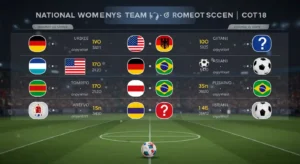The world of women’s soccer is more competitive than ever, and if you’re trying to keep up with who’s on top globally, the FIFA Women’s Rankings are your go-to source. Updated regularly by FIFA World Cup, these rankings reflect the form, performance, and progress of national women’s teams across the globe.
Whether you’re a die-hard fan, a youth player tracking your dream team, or a data nerd analyzing team trends, this article has all the info you need explained in a clear, user-friendly way.
FIFA Women’s World Top 10 Teams – June 2025 Update
Here’s the latest Top 10 FIFA Women’s National Teams as of June 2025:
| Rank | Country | Total Points |
|---|---|---|
| 1 | United States | 2,168 |
| 2 | Germany | 2,154 |
| 3 | England | 2,133 |
| 4 | Spain | 2,120 |
| 5 | France | 2,109 |
| 6 | Canada | 2,095 |
| 7 | Brazil | 2,084 |
| 8 | Netherlands | 2,077 |
| 9 | Japan | 2,062 |
| 10 | Australia | 2,048 |
What Are FIFA Women’s Rankings?
The FIFA Women’s Rankings are an official list maintained by FIFA that ranks national women’s soccer teams based on performance in international matches. The rankings use a points-based system that evaluates:
-
Match results (win, loss, draw)
-
Importance of the match (friendly vs. World Cup)
-
Strength of the opposing team
-
Goal difference
The rankings are updated every three months and are crucial for seeding in tournaments like the FIFA Women’s World Cup, Olympics, and continental competitions like UEFA Women’s Euro or CONCACAF W Championship.

USA Women’s National Team (USWNT) – Still on Top?
Yes, despite fierce competition, the USWNT continues to hold the No. 1 spot in the world rankings. Thanks to their strong performance in Olympic qualifiers and a dominant run in friendlies, they maintain a slim lead over Germany.
Highlights for the U.S. Women’s Team in 2025 so far:
-
Victory in the SheBelieves Cup 2025
-
Wins over Brazil, England, and Canada
-
Emerging stars like Alyssa Thompson and Jaedyn Shaw making a global impact
How FIFA Calculates Women’s Rankings
FIFA uses a “SUM” model, where:
-
Teams gain points for wins, especially against higher-ranked opponents
-
Draws offer fewer points but are valuable vs. stronger teams
-
Match type affects points: Competitive matches (World Cup, Olympics) offer more weight than friendlies
Formula Summary:
New Points = Old Points + Match Importance × (Result - Expected Result)
This means beating a stronger team earns big points, while losing to a lower-ranked team can hurt badly.
Regional Powerhouses to Watch in 2025
Europe (UEFA):
-
England and Germany are dominating the European scene.
-
Spain, fresh off their 2023 World Cup win, continue to climb the rankings.
North America (CONCACAF):
-
USA and Canada remain top contenders.
-
Mexico is rising quickly after investing in domestic women’s leagues.
South America (CONMEBOL):
-
Brazil is still the queen of South American soccer.
-
Keep an eye on Colombia, now breaking into the top 20.
Why the FIFA Women’s Rankings Matter
Understanding the rankings isn’t just for soccer geeks—it matters for:
-
Tournament Seeding: Avoiding early matchups against other strong teams.
-
Olympic and World Cup Qualification
-
National Funding and Support: Better rankings often mean more investment at the national level.
-
Fan Awareness: Helps fans track team growth and performance.

Where to Check Live FIFA Women’s Rankings
Want the most updated info every month?
-
Visit FIFA.com (Official Source)
-
Use the FIFA+ App for notifications
-
Follow official national teams on social media (e.g., @USWNT)
What’s New in June 2025?
-
Introduction of youth weighting in ranking formulas
-
More importance given to away victories
-
Updates after Olympic qualifiers had a major impact on the current table
-
Africa and Asia both saw teams jumping 5+ ranks due to strong 2024 tournament runs.
When Are FIFA Women’s Rankings Updated?
Every 3 months:
-
March
-
June
-
September
-
December
👉 The next update will be in September 2025.
FIFA vs. ELO Women’s Rankings – What’s the Difference?
| Feature | FIFA Rankings | ELO Rankings |
|---|---|---|
| Official by FIFA? | ✅ Yes | ❌ No |
| Updates Frequency | Quarterly | After every match |
| Includes Goal Margin? | ✅ Yes | ✅ Yes |
| Preferred by Analysts | ❌ Less | ✅ More |
FAQs: FIFA Women’s Rankings
Q1: How often are the FIFA Women’s Rankings updated?
Every 3 months March, June, September, and December.
Q2: Do the rankings affect the Women’s World Cup?
Yes, they impact the draw and seeding for all FIFA-organized tournaments.
Q3: Can friendly matches affect rankings?
Yes, but they have a lower point value compared to qualifiers and tournament games.
Q4: Which team gained the most ranking points in June 2025?
Colombia gained the most, jumping 6 spots after strong Olympic qualifier results.
Q5: Can a single win change a team’s ranking significantly?
Yes especially if it’s an away win against a higher-ranked opponent in a major tournament.
Q6: How many national teams are included in FIFA Women’s Rankings?
As of June 2025, over 180 national women’s teams are officially ranked by FIFA.
Final Thoughts
The FIFA Women’s Rankings are more than just numbers they’re a reflection of how nations are investing in and supporting women’s soccer. For U.S. fans, it’s exciting to see the USA still at the top, but the gap is closing, and the competition is heating up.
Stay tuned, because the road to the Women’s World Cup 2027 is already underway, and these rankings will play a big part in shaping that journey.


